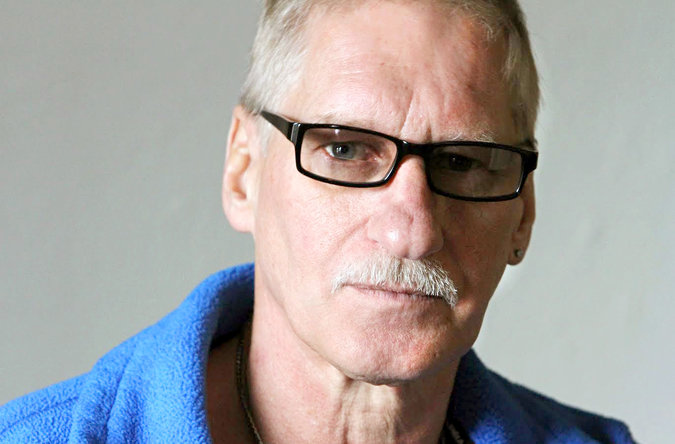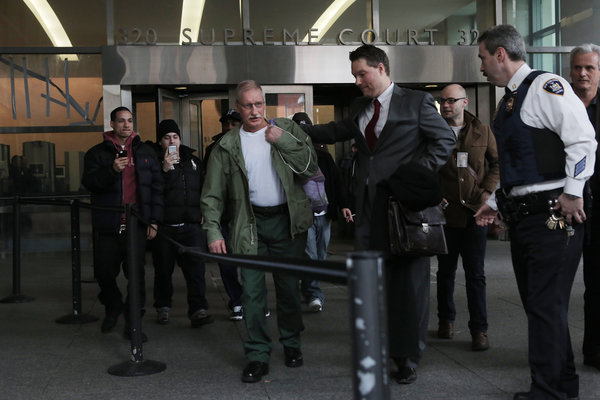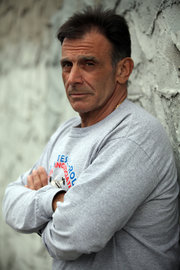
Man Framed by Detective Will Get $6.4 Million From New York City After Serving 23 Years for Murder
FRANCES ROBLES
David Ranta, wrongly convicted in a 1990 killing, was freed last year. The office of New York City’s comptroller settled the case before a suit had been filed. Credit David B. Hollingsworth for The New York Times
A man who was framed by a rogue detective and served 23 years in prison for a murder he did not commit will receive $6.4 million from the City of New York in a settlement that came before a civil rights lawsuit was even filed, lawyers involved in the case said on Thursday.
A $150 million claim filed last year by the man, David Ranta, was settled by the city comptroller’s office without ever involving the city’s legal department — which the lawyers involved in the negotiations described as a “groundbreaking” decision that acknowledged the overwhelming evidence the city faced.
The comptroller’s quick acceptance of liability in the high-profile conviction is also significant because the case is the first of what is expected to be a series of wrongful conviction claims by men who were sent to prison based on the flawed investigative work of the detective, Louis Scarcella, who has been accused of inventing confessions, coercing witnesses and recycling informers.
“While no amount of money could ever compensate David for the 23 years that were taken away from him, this settlement allows him the stability to continue to put his life back together,” Mr. Ranta’s lawyer, Pierre Sussman, said. “We are now focusing our efforts on pursuing an unjust conviction claim with the State of New York.”
Mr. Sussman added that Mr. Ranta, who, at 58, had a heart attack the day after he was released last March, “would like everyone to know he is happy to have a chance at recovering his health, taking care of his heart and being there for his family and children.”
Mr. Ranta, who declined to comment on Thursday, was convicted of the 1990 killing in Brooklyn of a Hasidic rabbi, Chaskel Werzberger, a Holocaust survivor who had stepped into his car at dawn just as a jewelry robbery was taking place across the street. He was shot in the head and his station wagon was used as a getaway car while the jeweler escaped unharmed.
The rabbi’s death shook the Orthodox Jewish community in Williamsburg, which was a major voting bloc for the newly elected district attorney at the time, Charles J. Hynes.
Mr. Hynes’s office defended the conviction for decades, fighting off appeals and rejecting evidence that pointed to another killer. But when one eyewitness came forward decades later to say that a detective had told him to pick the man with “the big nose” out of a lineup — Mr. Ranta was the only person who fit that description — the district attorney’s Conviction Integrity Unit conducted a yearlong investigation and discovered more serious problems.
When investigators approached two other witnesses in the case, they immediately admitted that they had lied.
The two career criminals who implicated Mr. Ranta in the crime used their cooperation in the case as a means to obtain get-out-of-jail excursions provided by Mr. Scarcella, who before retiring had been well regarded for his ability to solve homicides at a time when Brooklyn was awash in violence. He has repeatedly denied any wrongdoing.
Mr. Ranta had always accused the detective of manufacturing his confession. Mr. Scarcella said Mr. Ranta confessed while handcuffed to a bench at Central Booking. Although the allegation about the confession was never proven, the mounting questions about Mr. Scarcella’s methods made it increasingly suspect.
Prosecutors also discovered that Mr. Scarcella had followed up on an anonymous telephone call that attributed the killing to a robber named Joseph Astin. Mr. Scarcella questioned Mr. Astin’s wife and tried to track down a parole officer to collect recent photographs of him. But he dropped that lead when Mr. Astin died in a car accident, and then the officer never submitted any paperwork documenting the time spent investigating him.
Years later, Mr. Astin’s widow came forward to say her husband was the real killer, but legal efforts to free Mr. Ranta based on that information failed.
Two months after Mr. Ranta was released, he filed a notice that he would sue the city. Negotiations took place for several months under the previous comptroller, John C. Liu. But it was Mr. Liu’s successor, Scott M. Stringer, swayed by the fact that the Brooklyn district attorney’s office had joined in the motion to free Mr. Ranta from prison, who ultimately agreed to settle the case.
“This settlement is in the best interests of all parties and closes the door on a truly regrettable episode in our city’s history,” Mr. Stringer said in a statement. “I am pleased that my office was able to move quickly on this case.”
A spokesman for the city’s Law Department, which would have had responsibility for defending the city had the case proceeded, declined to comment on the settlement, which is among the largest the city has ever reached with an individual.
Mr. Ranta is expected to make a separate wrongful conviction claim against the state. Attorney General Eric T. Schneiderman proposed legislation on Wednesday that would make it easier for people like Mr. Ranta to make such claims; under current law, it is difficult for people who made false confessions to be compensated for wrongful convictions.
The news of the settlement came as Kenneth P. Thompson, the Brooklyn district attorney, convened a new three-member panel to review dozens of Mr. Scarcella’s cases. The panel is to replace the one appointed by Mr. Hynes, which was widely criticized for including several people close to him, including campaign donors and the godfather of his children. Dogged by the fact that the majority of the cases that involved questionable behavior by Mr. Scarcella took place under his watch, Mr. Hynes was voted out of office in November in a landslide victory for Mr. Thompson.
According to Mr. Thompson’s office, his review panel will include Bernard W. Nussbaum, a former White House counsel to President Bill Clinton who was forced out over his role in an investigation of a failed savings and loan; Gary S. Villanueva, a defense lawyer and former assistant district attorney in Brooklyn; and Jennifer G. Rodgers, a former federal prosecutor who is now the executive director of the Center for the Advancement of Public Integrity at Columbia University.
Details of their responsibilities have not been ironed out, but they are expected to play an advisory role in the dozens of innocence claims that have arisen in cases investigated by Mr. Scarcella.
After Mr. Ranta’s release, an investigation by The New York Times found that Mr. Scarcella had used the same witness in several different murder cases and that at least six confessions had included similar phraseology: “You got it right. I was there.” Some confessions did not match the evidence.
One inmate, Sundhe Moses, who had been investigated by the detective, hired lawyers who tracked down a star witness, who said detectives had coached him to lie. The Parole Board released Mr. Moses in December after he served 16 years for the murder of a 4-year-old girl.



